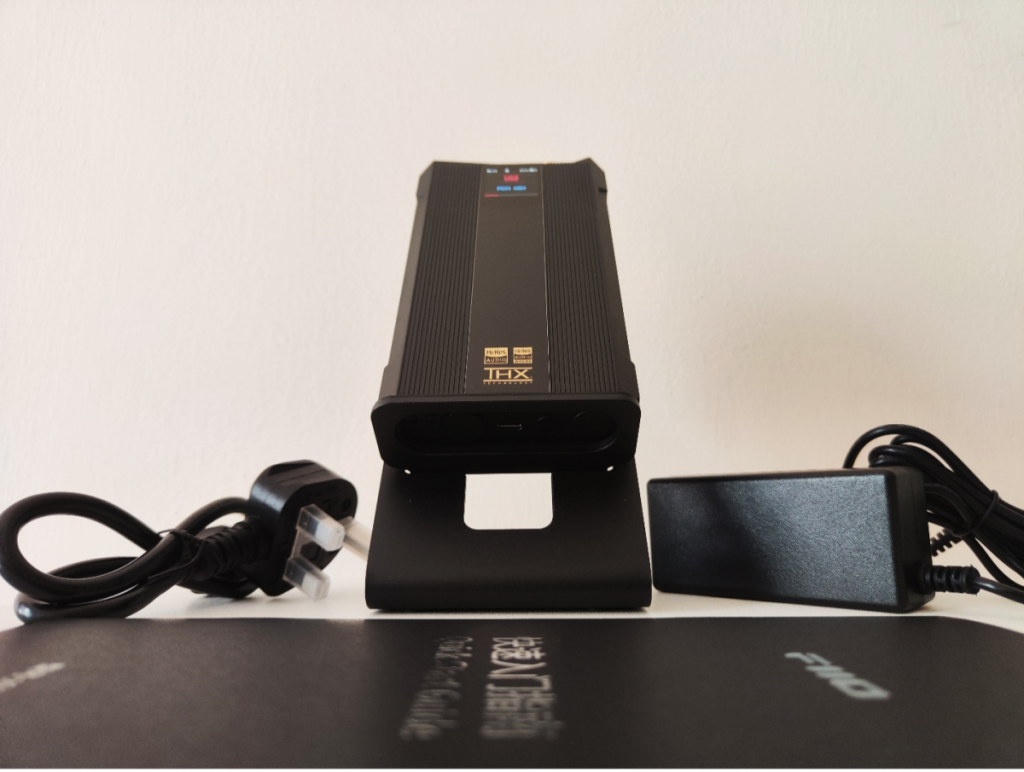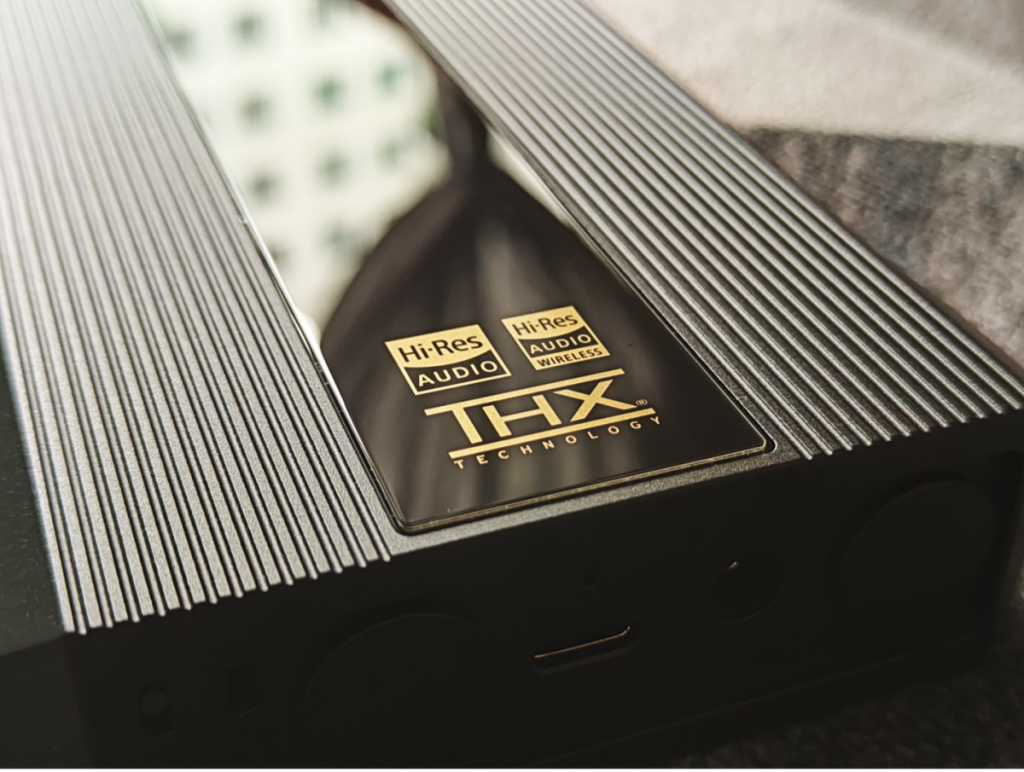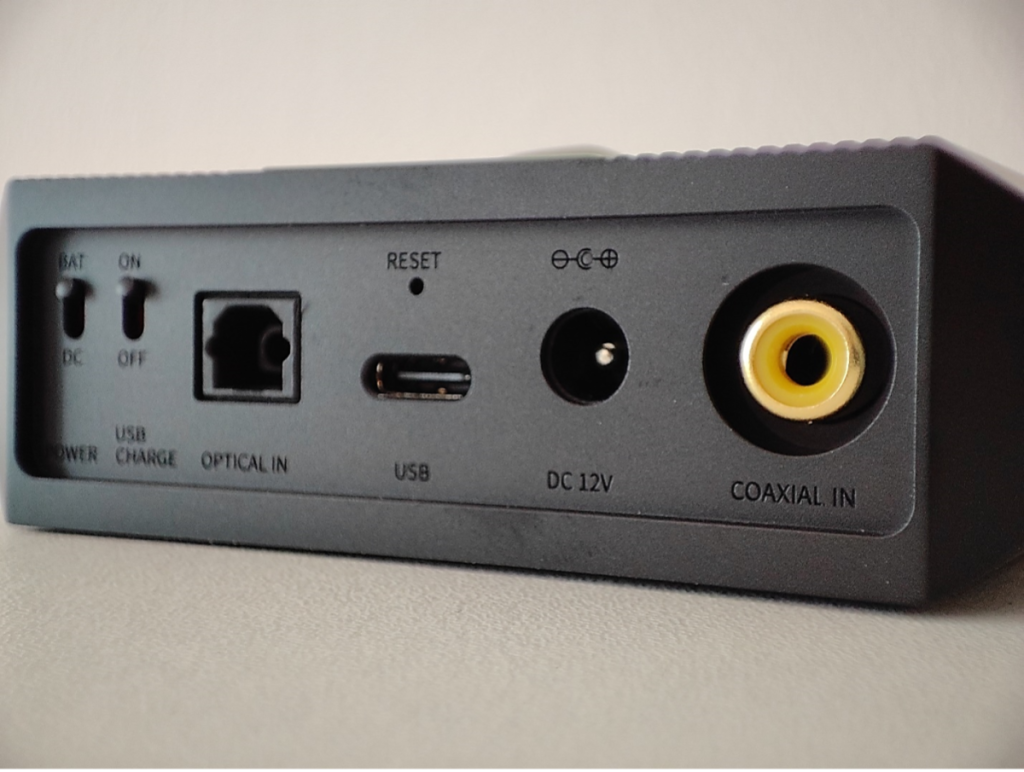Introduction
The year is almost 2023. The audiophile community has been blessed and celebrated by audio brands and manufacturers who are competitively pushing their knowledge and technical know-how to the limit in expanding their creativeness with their audio products. While the USB dongle market is currently booming due to many mobile corporations’ recent trend of abandoning the 3.5mm output jack for good (or bad), many audiophile brands are seeing this as an opportunity, hence defying physics and engineering to get the best sound quality dongle with the size of a mere human finger. Accepting this challenge is unquestionably beneficial to the future of audio. However, some manufacturers remain true to tradition, honouring the market for classic-sized portable DAC/AMPs despite their questionable portability. Whatever it is, the market is still competitive, although slow in progression. This brings us to the newly released Fiio Q7, whose innovation suits the challenge of producing desktop-level sound quality in a portable design. Undoubtedly, this product will be sold at a very high price as this will be their latest portable DAC/AMP flagship. Do you think they succeeded with this one? Enjoy the read.
Packaging & Accessories
The Q7 came in a big and heavy box for a portable device. However, you will likely understand the reason for this due to the included accessories, multifunctional dock, and the gigantic unit itself. Fiio usually has a good track record with their cables and peripherals’s generosity. This time is no exception; necessary cables and connectors are included along with a decent DC power supply unit but unfortunately, no cable for coaxial, optical, and line output included.
Build & Design
According to Fiio, the Q7 featured a “next-gen mech design.” To be honest, it appears a little too “gamery” for my tastes, as I prefer something more elegant or classy. But I’m reaching the region of subjectivity here, so you may or may not love the look. Nonetheless, with a weight of half a kilogram, it feels solid in the hand. Technically, this is a transportable device, which is perfect for a hybrid desktop-portable unit rather than a true portable DAC/AMP due to the heaviness and unfriendly pocketability characteristics. Additionally, Q7 also featured a tiny 1.3″ LCD screen for a convenient sample rate indicator and menu display. The pressable volume knob controls the volume with a maximum of 120 steps as well as the menu for various settings. The feel is not the most enjoyable one, but the knob does the job brilliantly without any responsiveness issues. There are also power, play/pause, and track change buttons on the right side. Since Fiio decided to integrate the battery powered Q7 with a DC input for more power output, the cooling design would be challenging for a device of this size. Since the Q7 can output 3W of power, it runs mildly hot most of the time when in DC mode! So, the DK3 external dock fan is useful to ease the heat dissipation process. The fan has a two-level fan speed, where the fastest speed produces a noticeably loud fan noise. You may or may not get annoyed with the noise, depending on your tolerance.

Features
Fiio and features are inextricably linked. I suppose their core business model is to provide everything people require in each of their audio products. I’ll try to keep it short.
Input and Output
Starting with output and input, the Q7 has every headphone output (PO) that exists in this world, namely 6.35mm and 3.5mm for standard single-ended (SE) as well as 2.5mm and 4.4mm balanced (BAL) outputs. The 3.5mm and 4.4mm connectors also support line output, allowing you to use your preferred external amplifier while the Q7 acts solely as a DAC. On the bottom of the device are another four inputs: (1) USB-C for data and charging, (2) 6.2mm DC input, (3) RCA for coaxial input, and (4) Toslink for optical input. The COAX and OPT inputs are useful if you want to connect the Q7 to your TVs, CD players, etc. In addition, two switches are located at the bottom: (1) the battery/DC switch and (2) the USB charge on/off switch. With the former, you have the option to disable the DC mode even when the DC power supply is plugged in, while the latter switch allows the user to enable or disable charging ability through the USB. These features are very much welcomed to avoid further overheating and unwanted noises and interferences during music playback.
Menu Settings
Just by turning and pushing the volume knob, the menu can be controlled easily through the LCD screen. Pushing the volume button once will let you choose which input mode you’d like to use. Holding the volume knob for 2 seconds lets you scroll through plenty of settings such as gain setting, switching PO/LO for the SE and BAL ports, toggling fixed or adjustable volume in LO mode, limiting maximum volume level, switching between auto-enabled or manually enabled UH mode when DC input is plugged in, DAC filters (fast, slow, mini, mini slow, apodizing, hybrid fast, brick wall), adjusting screen brightness and timeout, choosing USB audio version (UAC 1.0 or 2.0), changing language (English or Chinese), doing a factory reset, and finally checking firmware version. This level of proficiency in controlling various things with the device is truly remarkable. One thing to note here, the DAC filters are useless to provide any meaningful sound change based on my experience. This seems to be the trend of having an ESS Sabre DAC so far.

Bluetooth and Fiio Control App
No, Fiio didn’t stop there. Just as with their previous products, Bluetooth receiving mode connections enhance the controllability experience with functions such as RGB light control, channel balance, and an equalizer via the Fiio Control app. In addition, there is an OTA firmware upgrade function that is not yet available in the app. Just a disclaimer: note that I was using Android as my operating system while testing this feature. Hence, I do not know how the experience with iOS will be. Practically, with my Android smartphone, the LDAC connection is always connected to the Q7 within 10 metres or so, offering good sound quality over other codecs, although it is still inferior to a wired connection.

Ultra-High Gain Mode
There aren’t many portable AMPs with three, let alone five, different output gains! Yes, the Q7 has five gain levels: low, medium, high, super high, and ultra-high, which can only be activated when the DC power supply is plugged in. With UH mode, enhanced over-ear headphone mode is activated to produce a whopping 3W of power output at 32Ω. My recommendation is to always attach the DK3 dock-fan while using the UH gain to reduce the heat coming out of the Q7. Based on my testing, the UH mode does increase the sound quality in terms of soundstage size, especially with the BAL output. However, if there is one observation I can make, the low-end region was slightly attenuated in this mode despite the mentioned improvement. Therefore, synergy between the Q7 and your transducers should still be considered.
Battery and Charging Performance
With the extraordinary 9200 mAh battery capacity, I managed to obtain approximately 8–10 hours of playback with different gains in between. This corresponds to the advertised duration on Fiio’s spec sheet. PD charging is supported when a 9V power adapter is connected through the USB-C. Meanwhile, fast charging is enabled when a DC input (12V) is connected. With DC charging, the Q7 took ~4 hours to fully charge the unit, which is fine for that size of battery.
Parameters:
| SPECIFICATION | |
| DAC | ESS Sabre ES9038PRO |
| AMP | THX AAA 788+ (x2) |
| USB | XMOS XU316 |
| Bluetooth | QCC5124 |
| Weight | ~620 g |
| Display Screen | TFT LCD (1.3”) |
| Headphone Output | SE: 3.5mm (+LO) / 6.35mm BAL: 2.5mm / 4.4mm (+LO) |
| Input Mode | USB, COAX, OPT, Bluetooth |
| Battery | 9200 mAh (Lithium polymer) |
| Audio Format | PCM (768 kHz) DSD (512) MQA (Decoder + Renderer 8x) |
| Bluetooth Codec | SBC, AAC, aptX/LL/HD/adaptive, LDAC |
| Gain | Low, Medium, High, Super High, Ultra High (DC mode) |
| Power Supply | PD: 9 V (Quick charge) DC: 12 V / 2 A |
| PERFORMANCE (SH & UH gain) | ||
| 3.5mm | 6.35mm | PO | 2.5mm | 4.4mm |
| < 0.0005 % | THD+N (@32 Ω) | < 0.0005 % |
| < 2.8 µV | Noise Floor | < 4.5 µV |
| < 1.2 Ω | Output Impedance | < 2.2 Ω (SH) | < 1.7 Ω (UH) |
| ≥ 75 dB | Crosstalk | ≥ 114 dB |
| ≥ 122 dB (SH) | ≥ 125 dB (UH) | SNR | ≥ 125 dB |
| 12.4 Vpp (SH) | 17.8 Vpp (UH) | Peak Voltage | 25 Vpp (SH) | 35.3 Vpp (UH) |
| 550 mW (SH) | 1100 mW (UH) | Power Output (@32 Ω) | 1500 mW (SH) | 3000 mW (UH) |
Here is the most probably seek technical information that has been simplified for easier read. For more detailed specifications and measurements refer here.
Retail Price & Where to Get
Thank you, RED APE and Fiio for providing us the unit for review and testing. The Fiio Q7 is officially priced at RM 3,699 and can be found at RED APE (official distributor).
Shopee : https://invl.io/clfczvn
Lazada : https://invol.co/clfczw7
Test Tracks
Sound Quality
This time I’m changing up a bit my usual way of describing sound to better accommodate the intention and performance of a DAC/AMP (source) like this, in comparison to headphones and whatnot. I’ll also be using the K9 Pro ESS (desktop DAC/AMP) as a reference point for an easier understanding of the Q7’s sound performance. Don’t worry, the usual parameter ratings can still be seen in the rating section.

Sound Signature and Detail Retrieval
The Q7 has an absolutely neutral and transparent sound signature. Having a dual THX AAA 788+ amp topology resulted in this linear and ultra-low noise and distortion, highlighting minute details and nuances in the recording of a song like never before. I was genuinely surprised with the degree of resolution, amount of details, and effortless separation between every instrument and note produced by the Q7, which seems to be ahead when compared to its bigger brother, the K9 Pro ESS. The K9 is not a coloured DAC/AMP by any means, but it is when directly compared to the Q7. The former has that extra sense of punchiness to the low-end frequencies and smooth treble brilliance, resulting in a more enjoyable and fun yet still neutral sound signature. I believe that with power hungry planar headphones, the K9 would be an amazing combination in comparison to the Q7. This is due to the Q7’s flat neutral signature without any frequency masking or added “flavor,” which is more suitable for the bass-light character of most planar headphones. Therefore, you are going to make a choice here if you want to trade technical performance with addictive bass punch if choosing the K9 Pro ESS. This observation was apparent in the Stay With Me cover by Tokimeki Records feat. Hikari.
Dynamic and Separation
Anyhow, the Q7 definitely excels in dynamism and transient response. Everything sounds so blazingly fast or rightfully slow when called upon by the music. In Drive Home by Steven Wilson, the start of the guitar solo by Guthrie Govan is welcomed with a powerful snare. Here, the Q7 reproduced that moment of dynamic brilliantly and continued the increasing flow of busy passages with clear-cut definition. During the climatic guitar solo, Wilson’s vocals repeatedly chant “drive home,” which is truthfully layered behind Guthrie’s solo. This portrays the excellent separation outputted by the Q7 due to its excellent transient response charged into my IEM at that time. In Night Sprite by Chick Corea, Steve Gadd’s insane drumming speed also makes it no problem for the Q7 to catch up. Moving on to my next quest to test song accuracy, I tested the song Breeze And You by T-Square. This Japanese funky record didn’t mix particularly well, as it sounded slightly harsh and thin to my ears. And the Q7 stays true to the sound in comparison to the K9 Pro ESS, which is more forgiving with this record. By the way, the Hirotaka Izumi piano solo on this record is just outrageous, and thank God it is rendered with full texture on the Q7.

Imaging and Soundstage
Do you believe that the soundstage is a product or a subset of imaging? Think about it, because it makes sense since everything you hear is just some frequency of sound waves. Thus, the image localization of those frequencies resulted in the accuracy of the instrument position and also size perception of the soundstage with respect to your personal HRTF. But I digress. Q7, on the other hand, carries low distortion and noise-free performance as well as a high degree of crosstalk with either of its SE or BAL outputs. Consequently, this results in tremendous imaging precision in three-dimensionality. Any song that I played sounded big and massive, with a strong sense of space in the recording. Human Nature by Michael Jackson is a complex song with hidden instruments and vocals in the background. With Q7, you can just hear everything clearly due to the pinpoint accuracy. In UH mode with the DC plugged in, the soundstage seems to be more open and airier. With certain tracks, stereo separation can be really strong, as if the song were played out of phase. Again, I didn’t notice this kind of performance with the desktop K9 Pro ESS.

Synergy
Low output impedance is an important factor for an amplifier to stay neutral and remain silent with high-sensitivity in-ear monitors. Q7 has different output impedances based on the PO, but they all fall below 2.2Ω which is not the best we have seen but still pretty low. I couldn’t notice any noise floor with my most sensitive IEMs, such as the CCA CRA and Audiosense DT200. When it comes to sound quality, I found that using BAL output gave the best sound. The SE output seems to have a somewhat dull sound, regardless of the gain level. Perhaps this is due to the crosstalk and SNR being higher with the BAL output. In terms of sound pairing, and as I’ve mentioned previously, the Q7 has a super transparent sound and linearity; therefore, any IEM and headphone should sound like they are. Nonetheless, since neutral sources will match nicely with warmer sounding cans, I generally like the Q7 with CCA CRA, Audiosense DT200, and Moondrop Aria. If I’m craving total analytical sound, Sonic Memory SM2, Moondrop Variations, and Tanchjim Oxygen pair really well with the Q7.

Conclusion
The Fiio Q7 is a product that almost sacrifices portability for utmost sound quality and driving power. Ergonomically, it is a transportable product rather than a true portable device. Still, as a DAC/AMP, it features a lot of useful functions and accessibility features. Some of the highlights of this powerful Q7 include an LCD screen display, five levels of gain, DC input mode, Bluetooth capability, and smartphone app integration. Not to forget the DK3 multifunctional dock-fan to transform your Q7 into a desktop setup to serve that absurd 3W power output. Impressive internal specifications and measurements across all outputs and gains also help the Q7 to produce an astounding sound quality, especially with its resolving power, rivalling his desktop brother, the K9 Pro ESS, and costing half of Fiio’s true flagship, the M17 DAP, with the exact same specifications only without the touchscreen and Android capability. Sure, listening to a superbly linear and transparent source can be boring or sterile, but the authenticity of your music can be truthfully captured and reproduced by your favourite pair of headphones and monitors. It is indeed desktop-level audio quality in such a small package as a DAC/AMP.









